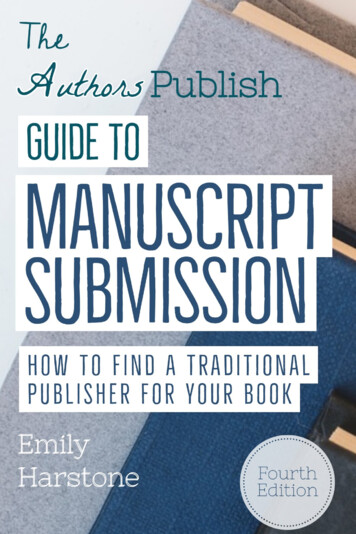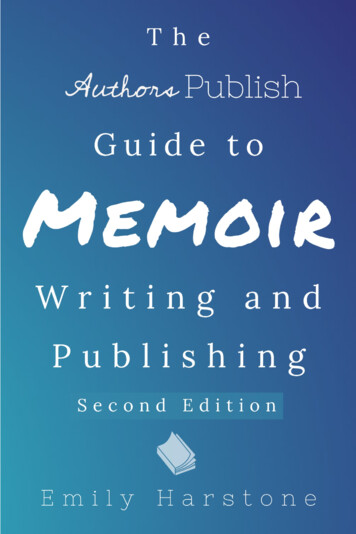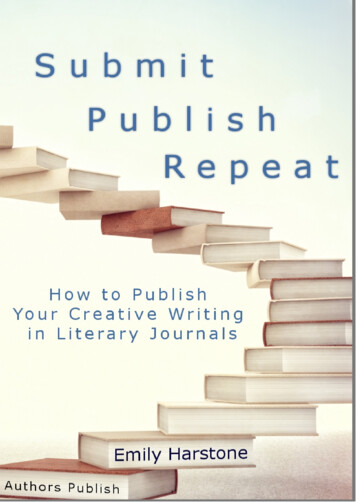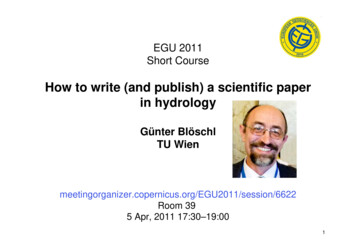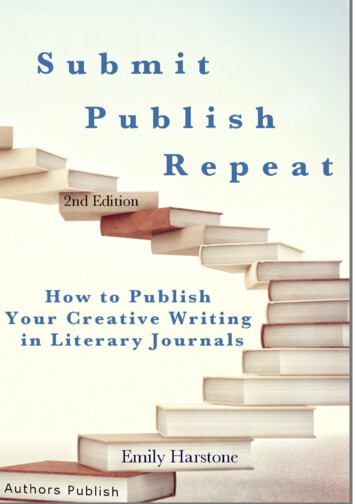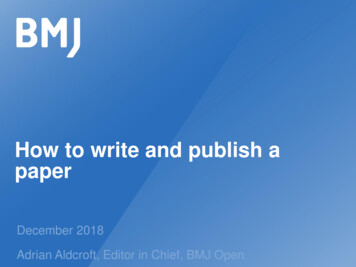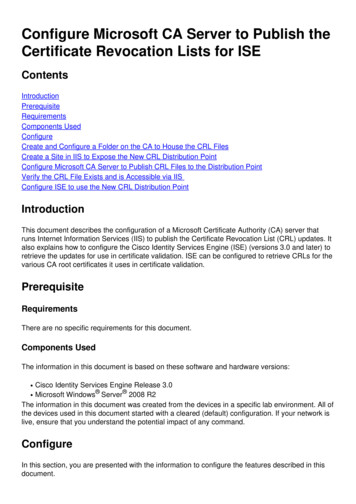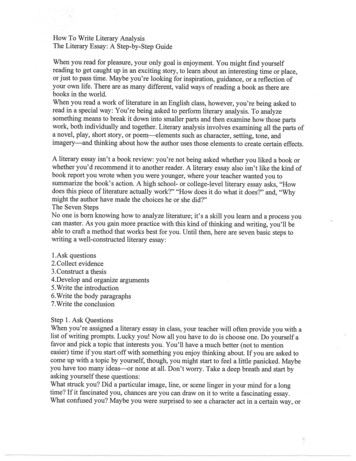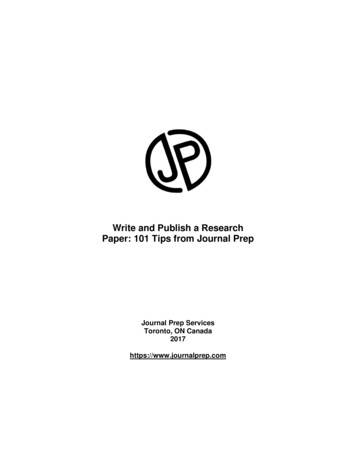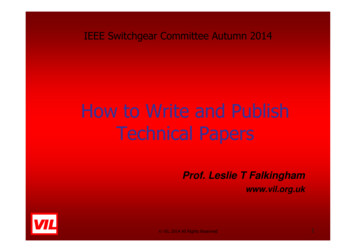
Transcription
IEEE Switchgear Committee Autumn 2014How to Write and PublishTechnical PapersProf. Leslie T Falkinghamwww.vil.org.uk VIL 2014 All Rights Reserved1
IntroductionThis presentation covers the following topics:1.Why do you want to publish a technical paper?2.The advantages and disadvantages of publication.3.The 8 key requirements4.What must be in a paper for it to be published.5.The Peer Review process.6.How do you select which is the right publication?7.The rewards of publication. VIL 2014 All Rights ReservedIEEE 20142
Why do you want to publish a technical paper? It is required as part of a qualification It is required by your institution (Research assessment) It will help your career You want to be famous VIL 2014 All Rights ReservedIEEE 20143
Why do you want to publish a technical paper? You wish to pass on knowledge to othersKey Requirement # 1 VIL 2014 All Rights ReservedIEEE 20144
The advantages of publication. Spreads the knowledge to others Helps others working in the field May impact on your company, industry, country, humankindTells the world what you have done Adds to your Professional ReputationAffects how your colleagues see you and your Institution treatsyouMay lead to other things – National and International recognition VIL 2014 All Rights ReservedIEEE 20145
The disadvantages of publication. Spreads the knowledge to others Helps others working in the field May impact on your company, industry, country, humankindTells the world what you have done Adds to your Professional Reputation Affects how your colleagues see you and your Institution treats you May lead to other things – National and International recognition VIL 2014 All Rights ReservedIEEE 20146
What must be in a paper for it to be published. Spreads the knowledge to others A technical paper must be understandable to others in thefield. – If other people cannot understand it, it is of nointerestThe work must be repeatable – enough information shouldbe given to allow others to replicate the results or find theinformationThe relationship of the work to what is already known mustbe clearly statedWhat is new information must be identified VIL 2014 All Rights ReservedIEEE 20147
What must be in a paper for it to be published. Spreads the knowledge to others Understandable Repeatable Relationship to existing knowledge Identify what is new VIL 2014 All Rights ReservedIEEE 20148
The Paper Format Technical papers normally have a similarstructure: Synopsis Introduction discussion Conclusions References Author biography VIL 2014 All Rights ReservedIEEE 20149
The Paper Format Technical papers areshort – usually aroundsix to eight pages long –however the actual textcan be as little as two orthree pages. VIL 2014 All Rights ReservedIEEE 201410
The Paper Format This is because the Title, Synopsis andIntroduction sections can take up the firstpage, and the Conclusions,Acknowledgements, References, and Bio‘sof authors can take up the last page. Adda few photos and graphs and the text isactually quite small. VIL 2014 All Rights ReservedIEEE 201411
The Paper Format VIL 2014 All Rights ReservedIEEE 201412
The Peer Review process Peer ReviewThis a process of reviewing the paper by a number of experts in thefield. They will assess the paper based on their own knowledgeand experience for the following; Understandable Repeatable Relationship to existing knowledge Identifies what is new Is intellectually honest VIL 2014 All Rights ReservedIEEE 201413
The Peer Review process Peer Review Requirements Understandable Has the author presented the work and its context clearly andunambiguously?This does not mean is the English perfect! It just means that thepaper must be readable and understood by others. Papers are notrejected for bad English. Papers are rejected for being badlywritten so that they cannot be understood, sometimes these areones written by native speakers of the language!Data and graphs must be clearly labelled and understandable. Theymust also be referred to from the text and be relevent to thepaper.Key Requirement # 2 VIL 2014 All Rights ReservedIEEE 201414
The Peer Review process Peer Review Requirements Repeatable Has the author supplied enough information so that anotherworker in the field could closely repeat or confirm the work?This is important so that the work can be verified by others. Tosay that you have found a way to convert lead into gold is notenough, you must give enough instructions so that others canalso do it!You must pay attention to the equipment or methodologiesused, and specify carefully. This may have a significant effecton the results.Key Requirement # 3 VIL 2014 All Rights ReservedIEEE 201415
The Peer Review process Peer Review Requirements Reationship to existing knowledge Has the author clearly explained what is already known andhow this work fits into this existing knowledge?This is a weakness of many papers. It is very rare that papersare published on a completely new subject. The paper mustput the work into context and the author must refer to previouswork, reference it, and show an understanding of it. Failure todo this adequately is often a reason for rejectionKey Requirement # 4 VIL 2014 All Rights ReservedIEEE 201416
The Peer Review process Peer Review Requirements Identifies what is new Has the author clearly shown what part of the paper is their workand what is new, and what is based on the work of others?This is the heart of the paper and is often ignored. What is new?We know that much of the paper will show what the author orothers did previously, and also how this work was carried out. Itis important to state exactly what is actually new, why you thinkit is new, and what you think it means. This is the role of theDiscussion.If there is nothing new then it is not worth publishing. Note, a review paper or Meta analysis does give something new asthe analysis of the work in the field is itself new, but this must bedemonstrated.Key Requirement # 5 VIL 2014 All Rights ReservedIEEE 201417
The Peer Review process Peer Review Requirements Is intellectually honestThere are two types of intellectual dishonesty in Publications; Plagiarism: The adoption or reproduction of ideas or words orstatements of another person or which has been previously publishedwithout due acknowledgment. Fabrication: The falsification of data, information, or citations in thepublication.Key Requirement # 6Sources: adapted from Wikipedia article on Peer Review VIL 2014 All Rights ReservedIEEE 201418
The Peer Review process Peer Review Requirements Is intellectually honestPlagiarism: The adoption or reproduction of ideas or words orstatements of another person or which has been previously publishedwithout due acknowledgment. If you use someone else’s work you must clearly acknowledge itand identify it If you are a co-author of a paper you must have contributedsignificantly to the paper or the work in the paper. If you repeat text from your own previously published work youmust also acknowledge and reference it. Self plagiarism is notallowed.Sources: adapted from Wikipedia article on Peer Review VIL 2014 All Rights ReservedIEEE 201419
The Peer Review process Peer Review Requirements Is intellectually honestFabrication: The falsification of data, information, or citations in thepublication. Report the results accurately with no editing. If there are unexpected or anomalous results report them. If youhave no idea why they occurred say so. Do not select references which solely support your views – if thereis an opposing theory or viewpoint you should, as a minimum, saythis and not give the impression that the one presented is the onlyview. Falsification of data is the fastest way to destroy your reputation.There may be a temptation to « massage » the results to proveyour point or theory, but remember that once published the paperwill always be there to haunt you for the rest of your life andbeyond.Sources: adapted from Wikipedia article on Peer Review VIL 2014 All Rights ReservedIEEE 201420
How do you select which is the right publication? Types of Publication. There are four main types of publication; In-house publications Conference Papers Non reviewed journals Peer reviewed journals VIL 2014 All Rights ReservedIEEE 201421
How do you select which is the right publication? Types of Publication. In-house publicationThese are effectively press releases and are not academically rated.However, the internet is pervasive and be aware that these publicationsmay well be read and cited by others, so care must be taken tomaintain your credibility and integrity. If they are clearly wrong orbadly written it will reflect upon you. VIL 2014 All Rights ReservedIEEE 201422
How do you select which is the right publication? Types of Publication. Conference papers.These are often not peer-reviewed, but are widely seen as substantivetechnical papers and should be treated by the author as thoughthey are peer reviewed.They will be cited and will reflect upon your reputation. VIL 2014 All Rights ReservedIEEE 201423
How do you select which is the right publication? Types of Publication. Non reviewed journalsThese are technical journals which normally do not have a formal peerreview process. However instead the papers are reviewed normallyby the editors. Again these should be treated exactly the same asfor peer reviewed journals.Peer review is a modern trend and in the past century many influentialjournals used editor review only, and some researchers believethat this is not in principle inferior to the peer review method. Forexample Einstein’s 1905 papers on Physics and Relativity wasreviewed only by the journal editors – Max Planck and WilhelmWein, (who were both Nobel Laureats). VIL 2014 All Rights ReservedIEEE 201424
How do you select which is the right publication? Types of Publication. Peer reviewed journalsThese are technical journals which follow the peer review process, suchas IEEE Proceedings. Peer review has grown in popularity in recentyears to try to give more academic credibility to the publication oftechnical papers.A major reason for the increase in popularity being the preference forpeer reviewed publications in the rating of research prowess byacademic institutions, and the resultant huge increase in thenumbers of papers submitted for publication. VIL 2014 All Rights ReservedIEEE 201425
How do you select which is the right publication? Choosing which Publication. The choice of publication should be driven by Key Requirement #1.The wish to add to human knowledge. In this case it means thatyou should publish where the work will do the most good. Normallythis is in a specialist conference or a publication dealing with workin your field.Many papers are rejected due to being proposed for the wrongpublication. The rule is very simple. Will the people who read thisjournal be expecting this type of paper, and its subject, and willthey be interested in it? If the answer to any of these questions isno, then it is the wrong publication.Key Requirement # 7 VIL 2014 All Rights ReservedIEEE 201426
How do you select which is the right publication? Follow the publication rules. All publications have rules for submission, they are mainly similar,but each has its own variants. Normally there is a template whichmust be used, and there is a written procedure.You must read this carefully and then do exactly what it says.Many authors do not do this, and as a result, many authors’ papersare rejected.Key Requirement # 8 VIL 2014 All Rights ReservedIEEE 201427
How do you select which is the right publication? The process. Normally the paper will be submitted online. It will be read by theEditor and then a number of reviewers will be selected to look at itin detail. The editor will select the reviewers based on the subjectof the paper and the fields in which they are specialists.The Reviewers will read the paper and submit comments, both tothe editor and to the authors. They will choose one of four options. Publish as is Resubmit after minor rewrite Resubmit after major rewrite Reject VIL 2014 All Rights ReservedIEEE 201428
How do you select which is the right publication? The process.In each case the reviewers will state what is wrong, why, and whatneeds to be done. But although they will make suggestions theywill not rewrite the paper for you. Publish as is It is rare that this is the first response, normally papers requiresome work and at least one resubmission.Resubmit after minor rewrite This is the most common result. The paper is judged to beappropriate, interesting, and professional. It needs somecorrections or adjustment but is essentially good. VIL 2014 All Rights ReservedIEEE 201429
How do you select which is the right publication? The process. Resubmit after major rewrite This is where the paper has major flaws but is still thought tocontain worthwhile information. Normally the problem is thatKey Requirements 3, 4, or 5 have not been met. Repeatability,relationship to previous work, and clearly identifying what isnew, are common areas of weakness in submitted papers.Reject Often this is because of Key Requirement 7 or 8, – it is not thecorrect place for publication, or did not comply with the rules.But it may also be because of Key Requirement 5, or 6. Thereis nothing new, or the paper does not clearly meet the ethicalstandards required – if there is doubt it will not be published. VIL 2014 All Rights ReservedIEEE 201430
The rewards of publicationJan Hendrik SchönBorn 1970.Ph.D. 1997Schön rose to prominence since 2000 in the fields ofcondensed matter and nanotechnology. He obtainedhis Ph.D. at the University of Konstanze, Germany, in 1997 and thenjoined the prestigious Bell Labs as a researcher. His revolutionary work onthe organic transistor had potential to change the world of electronics, andwas featured in a large number of his peer reviewed papers.As a result of this published work Schön received the prestigiousBraunschweig Prize and the Otto Klung Weberbank Prize in 2001, and theOutstanding Young Investigator Award of the MRS (Materials ResearchSociety) in 2002.Clearly, this is what we think of when we talk of reputation and the role ofthe researcher in adding to human knowledge. This is a man who actuallychanged the world early in his career, and had a very bright future aheadof him.Sources Wikipedia and the BBC website. Photo from: Bing Search,http://2.bp.blogspot.com/ JUw2aRvPUwc/Sq4wVaycPuI/AAAAAAAAEgY/5H3So jOVF8/s400/Jan Hendrik Schon photo 4.gif VIL 2014 All Rights ReservedIEEE 201431
The rewards of publicationJan Hendrik SchönBorn 1970.Ph.D. 19972001 Braunschweig and the Otto Klung Prizes2002 Outstanding Young Investigator Award of MRSIn 2002 and 2003, 21 of his peer reviewed papers were withdrawn due toproven scientific fraud.In 2002 he was dismissed and left Bell Labs in disgrace.In 2004 his Ph.D. was removed for “dishonourable conduct”Although his coauthors were exonerated of fraud, their reputations weredamaged simply by being coauthors of papers which were later proven to befraudulent. If you are a coauthor you share responsibility for the paper.Clearly this is not what we think of when we talk of reputation and the roleof the researcher. This is a man who actually changed the world – but not ashe would have liked. His main effect is the reviewers and research institutesare now much more aware of intellectual fraud, and if in doubt will notpublish. VIL 2014 All Rights ReservedIEEE 201432
The rewards of publicationSir Cyril Ludovic Bart 1883-1971Honoured during his lifetime for his outstanding work on inheritedintelligence. This was used by many countries to introduce selectivestreaming in education. After his death new evidence has beenfound, and it is now believed that he had falsified his research datato support his theory.Cold fusion: 1989Despite being announced in 1989 no researcher has been able toactually reproduce the experimental results reported. There is noquestion of fraud, but the work is effectively disgraced, as are theresearchers Fleischmann and Pons.Sources Internet, Wikipedia and the BBC website. VIL 2014 All Rights ReservedIEEE 201433
The rewards of publicationKarl Thodore zu Guttenberg (Baron)Senior German politicianMember of parliament 2002 -2011Minister of Defence 2009-2011Youngest ever post war Minister of DefenceRegarded as a future Chancellor of GermanyPolitical career ended in March 2011.Sources Internet, Wikipedia and the BBC website. VIL 2014 All Rights ReservedIEEE 201434
The rewards of publication”Baron zu Googleberg”Minister for Cut and Paste.Ph D thesis Granted by University ofBeyrouth in 2006PhD revoked by the university inFebruary 2011 for « severe errors inworkmanship »An investigation by Bayreuth Universityfound that he had "grossly violatedstandard research practices and in sodoing deliberately deceived".Sources Internet, Wikipedia and the BBC website. VIL 2014 All Rights ReservedIEEE 201435
Conclusions Be careful when publishing technical papers. It isyour reputation and your career which is at stake.Once something is published you cannot change it.Remember the eight Key Requirements. If you followthem, publication is quite simple.Apply the highest standards of writing and integrityto all of your publications whether peer reviewed ornot. You will be judged on all of them.Don‘t worry if the paper is rejected at first withadvice to resubmit. This is normal, and actually not acriticism of you or your work.Good luck with your publication. If they are donewell, publications will help others, enhance yourcareer, and are something you can be proud of. VIL 2014 All Rights ReservedIEEE 201436
Questions? VIL 2014 All Rights ReservedIEEE 201437
you should publish where the work will do the most good. Normally this is in a specialist conference or a publication dealing withwork in your field. Many papers are rejected due to being proposed for the wrong publication. The rule is very simple. Will the people who read this journal b
